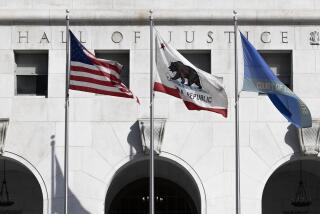Justice Vacated : Budgets: In 1989, L.A. County signed a 25-year lease on seven floors of an office tower for court space. But with no money for judges, half the courtrooms go unused.
Unlike the downtown Los Angeles courts with their noisy, hustling crowds, Central Civil West is so quiet that visitors’ footsteps echo along the corridors. Outside the jury assembly room, a revolving electric sign keeps repeating: “Please Stay Awake.”
“You’re not overly rushed here most of the time,” Superior Court Judge Ernest Hiroshige said.
The courthouse where Hiroshige sits is one of Los Angeles County Superior Court’s most unusual--and emptiest--halls of justice.
The only court facility inside a private office building, it was intended to increase judicial efficiency. Instead, tight budgets have left half the 23 courtrooms unused, lacking judges to conduct trials.
Meanwhile, the county pays more than $3 million a year under a 25-year lease signed in 1989 to rent the space--seven floors of a Mid-Wilshire office tower.
Adding to the frustration for county officials is the fact that the space--already molded into courts--cannot be used for other purposes. And the cash-strapped county cannot leave the building because “we have a contract,” said Judith Call, the court’s deputy executive officer.
Central Civil West, opened in 1991, was planned to provide more courtrooms as a way to ease the long waiting periods for civil disputes to come to trial. But the state Legislature has not increased the number of judges assigned to Los Angeles County, despite repeated requests.
“When they decided to do it, nobody knew the depths of this recession, and I guess this is one of the consequences,” said Superior Court Presiding Judge Robert M. Mallano.
Though two child custody courtrooms recently moved into the building, the other vacant courtrooms are not likely to fill up anytime soon. “We don’t expect to get any new judges for a couple of years,” Mallano said.
Real estate experts say the county paid fair market value--at the time--for its space in the 18-story glass-walled tower at 600 S. Commonwealth Ave., at the edge of Lafayette Park. The $297,000 monthly rental is paid through a court construction fund and includes the costs of transforming the space into courtrooms.
The hard economic times have had an impact beyond the court floors. The building has only a few other tenants, such as a law firm, an appraisal company and county health services. Three floors are vacant, with unfinished walls and bare concrete floors.
“We haven’t done anything with them because we haven’t got a tenant,” said Arthur Blech, the general partner of Commonwealth Enterprises, the building’s owner.
In June, Commonwealth filed a federal Chapter 11 bankruptcy petition in order to restructure debts of more than $24 million. “This is a common occurrence these days,” Blech said. “But . . . the courthouse will be there forever.”
Blech sees the building’s fortunes as part of the broader decline of the Mid-Wilshire area, once noted for its 1920s-era charm.
The landmark Art Deco Bullock’s Wilshire--I. Magnin department store has closed and so has the Sheraton-Town House Hotel across the street. Once-pristine Lafayette Park is filled with transients.
Though largely unused, the courthouse has many features that draw praise from those who work there. There are electronic recording machines to take testimony instead of human court reporters. Three courtrooms have video recording equipment.
Because the county had to adapt to the office building’s architecture, the courts are small, with fewer seats for spectators than in most courthouses and less space between the tables provided for lawyers.
“You’re sitting closer to everyone else,” said Douglas Porter, a judicial assistant to Superior Court Judge F. Ray Bennett, noting that lawyers have to watch that their notes are not seen by the opposing side.
Long trials often get assigned to Central Civil West to keep other Superior Court civil calendars moving on a fast track. “We’re overflow basically,” Judge Daniel A. Curry said. “When the water is going over the top, that’s what we’re here to handle.”
Curry is one of three full-time judges there, along with six retired judges on temporary assignments and two referees who handle the child custody and support cases.
The relative quiet in the building has created a decidedly more human, non-urban atmosphere. “It doesn’t seem real, it’s so calm,” said Rick Edwards, a deputy court clerk, from behind a deserted counter. Contrasted with the downtown civil courthouse on Hill Street, where he previously worked, “you can take the time to look stuff up, be more personal one on one.”
“It’s like being out in Ventura or Oxnard,” said Gloria Wilson, who tape-records proceedings in one court. “It’s more like a family atmosphere. If one goes out for an orange, they’ll bring back enough for everybody.”
Lawyers say they like the courthouse, too. James H. Davis, who has offices nearby, said the atmosphere sometimes approaches the surreal.
“One day we were up in a judge’s chambers, with windows that look right out on that park,” Davis said. “The attorneys in the case and the judge, we stood there and we all watched a drug deal go down, five stories below.”
More to Read
Sign up for Essential California
The most important California stories and recommendations in your inbox every morning.
You may occasionally receive promotional content from the Los Angeles Times.










